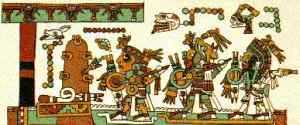Articles >>
Flower Wars
Category: Term of the day

A flower war or "Flowery war" is the name given to the battles fought between the Aztec Triple Alliance and some of their enemies: most notably the city-states of Tlaxcala, Huexotzinco, Atlixco and Cholula. In his Durán Codex, Diego Durán states that the Flower wars were instigated by the Aztec Cihuacoatl, Tlacaelel, because of a great famine that occurred during the reign of Moctezuma I that could only be assuaged through the means of human sacrifice which resulted in a treaty being signed between Tenochtitlan (the Aztec capital), Texcoco, Tlaxcala and Huexotzingo to engage in ritual battles to provide fresh victims. However another source, noble historian Chimalpahin Quauhtlehuanitzin, mentions an earlier Flower War between Mexica and the Chalca.
The sixteenth century chronicle a History of Tlaxcala, by Tlaxcallan Diego Muñoz Camargo contains a legend of a powerful Tlaxcalteca warrior called Tlahuiçole, who was captured, but because of his fame as a warrior he was freed and then fought with the Aztecs against the Tarascans in Michoacan. He received honors, but instead of returning to Tlaxcala he chose to die in sacrifice. There were eight days of celebrations in his honor, and then he killed the first eight warriors. Still insisting on being sacrificed, he fought and wounded 20 more warriors before being defeated and sacrificed.
The exact nature of the Flower Wars is not well determined but a number of different interpretations of the concept exist. The widely accepted idea of the Flower Wars is that it was a special institutionalized kind of warfare where two enemy states would plan battles through mutual arrangement in order to satisfy the religious needs of both combatants for war captives to use in sacrificial rituals, but also, possibly, to train young warriors and enable social mobility which for the lower classes was primarily possible through military service. This view is based on a number of quotes from early chroniclers and also from the letters of Cortés. However in recent years this interpretation has been doubted by scholars such as Nigel Davies and Ross Hassig, who argue that "the mutual arrangement" of the flower war institution is dubious, and suggest that Flowery War was in fact a low-intensity, sustained conflict with the Aztec side trying to fatigue the Tlaxcalteca in order to later conquer them entirely.
Though Hassig suggests that the interpretations about the Flower Wars have been exaggerated, he accepts that captives of these wars were in fact sacrificed. Hassigís point is that the captives of such wars were not the only ones to be sacrificed; that such captives participated only in some Aztec rites, and that they didnít participate in the ostentatious 1487 ceremony of dedication to the Great Pyramid of Tenochtitlan.
Aztec warriors are said to have been trained to prefer capturing their enemies in battle, rather than killing. This behaviour has been cited as another reason for the defeat of their civilization by the Europeans. To the Aztecs' amazement, the Spanish conquistadors and their allies actually tried to kill their enemies in battle. But this idea has largely been dismissed by Matthew Restall who makes it clear that the indigenous warriors quickly adapted their strategies to this kind of warfare, and provided the Spanish forces with fierce resistance. |
Discuss
